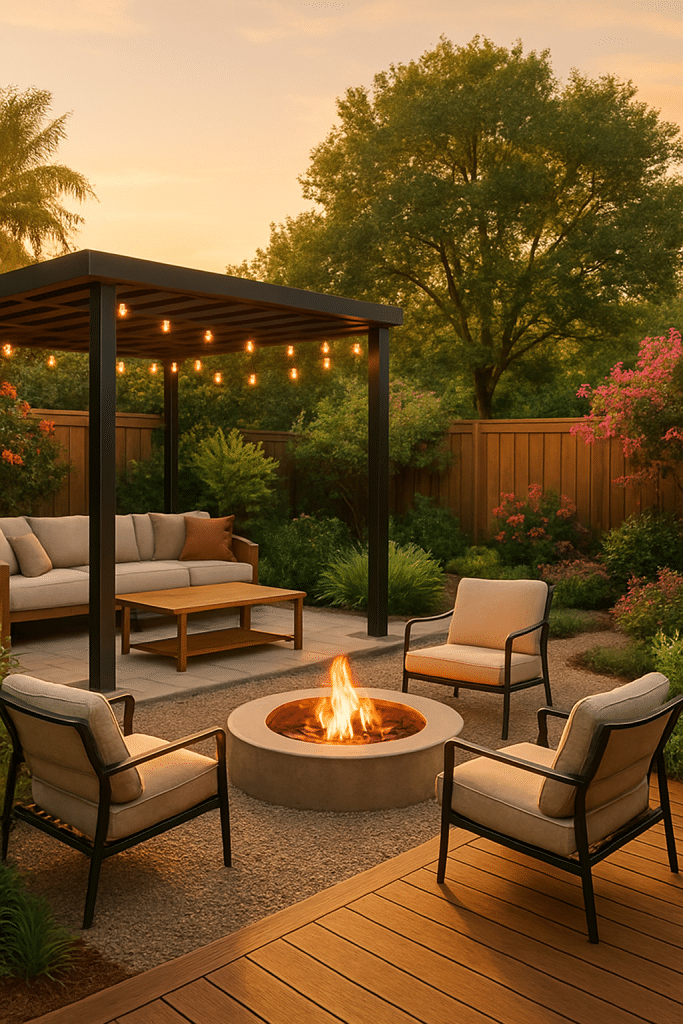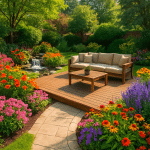A backyard is so much more than just an open space behind your home. It’s a blank canvas, a natural extension of your indoor living area, and a perfect place to unleash your creativity while enhancing your lifestyle. If you’re a homeowner seeking fresh, creative, and practical backyard design ideas, you’ve come to the right place. Over the next several thousand words, I’ll guide you through five inspiring backyard design concepts that marry beauty and functionality, tailored for all sorts of gardens — from small and awkward corners to steep slopes and sprawling spaces. I’ll also delve into smart solutions like outdoor kitchens, water features, sustainable landscaping, and more.
Together, we’ll explore how to assess your backyard’s potential, unlock the power of multi-level landscaping, incorporate eye-catching water features, and create cozy, family-friendly zones. By the end of this article, you’ll be equipped with actionable insights and expert tips to transform your backyard into the creative outdoor oasis you’ve always dreamed of. So let’s dig in and start designing a backyard that’s not only stunning but truly yours!
Understanding Your Backyard’s Potential
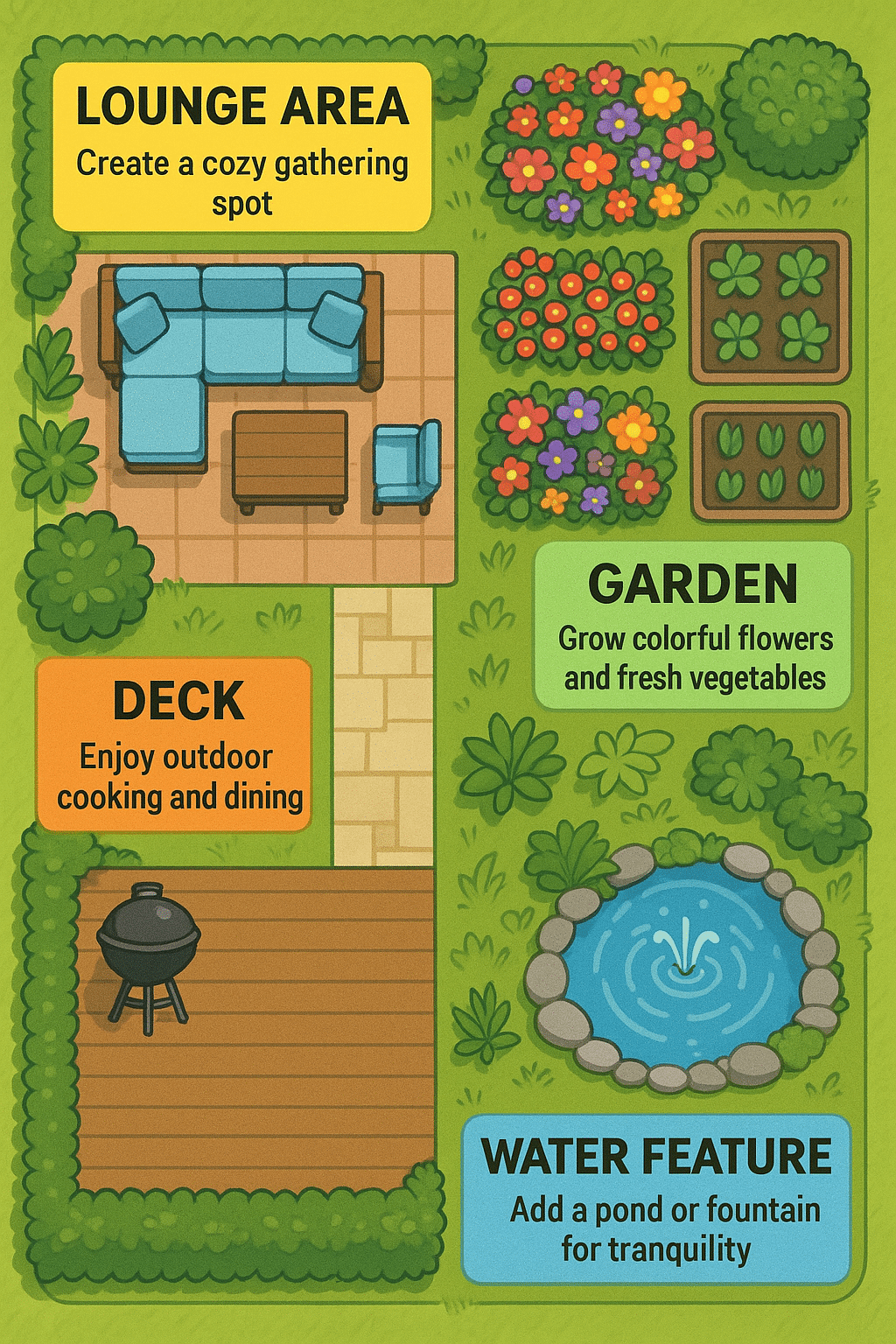
Before diving headfirst into design ideas, it’s essential to understand the fundamentals of your outdoor space. This initial assessment sets the stage for a purposeful and well-organized backyard that serves your needs and complements your home.
Assessing Space and Layout
The size and shape of your backyard directly influence what you can do. If you have a small or awkwardly shaped garden, you may need to rethink traditional layouts and go vertical or multi-level. Conversely, large backyards offer flexibility but demand a clear division of zones to prevent feeling overwhelming or underused.
Start by measuring the exact dimensions—length, width, elevation changes—and identify fixed elements like trees, fences, sheds, or large bushes. Consider how you currently use your space. Do you want more room for entertaining, gardening, or a play area for kids? Drafting a simple, to-scale outline on graph paper or using landscaping apps like SketchUp or iScape can help visualize possibilities.
Analyzing Soil, Sunlight, and Climate Factors
Understanding your soil type, sunlight exposure, and microclimate is critical for selecting plants and materials that thrive without excessive maintenance. For example:
- Sandy soil drains quickly and may need amendments with organic matter for planting.
- Clay soil holds moisture but tends to compact, requiring aeration.
- Full sun exposure suits Mediterranean and native drought-resistant plants.
- Shady areas under trees call for shade-loving ground covers and ferns.
Climate considerations—such as rainfall patterns and temperature ranges—guide your choice of water features, fire pits, and outdoor lighting that can endure seasonal changes.
Defining Functional Zones for Outdoor Use
Great backyard design hinges on clear functional zones that accommodate different activities harmoniously. Typical zones might include:
- Dining area: Often adjacent to the house or kitchen for convenience.
- Lounge seating: Comfortable spot with sofas or chairs around a fire pit or shade.
- Garden section: For plants, flowers, or vegetable beds.
- Play area: Safe, open space for children, possibly with durable surfacing.
- Water feature: Pond, fountain, or stream that adds tranquility and visual appeal.
By defining and mapping these zones early, you ensure a balanced and inviting backyard flow.
Creative Backyard Design Ideas for Small and Awkward Spaces
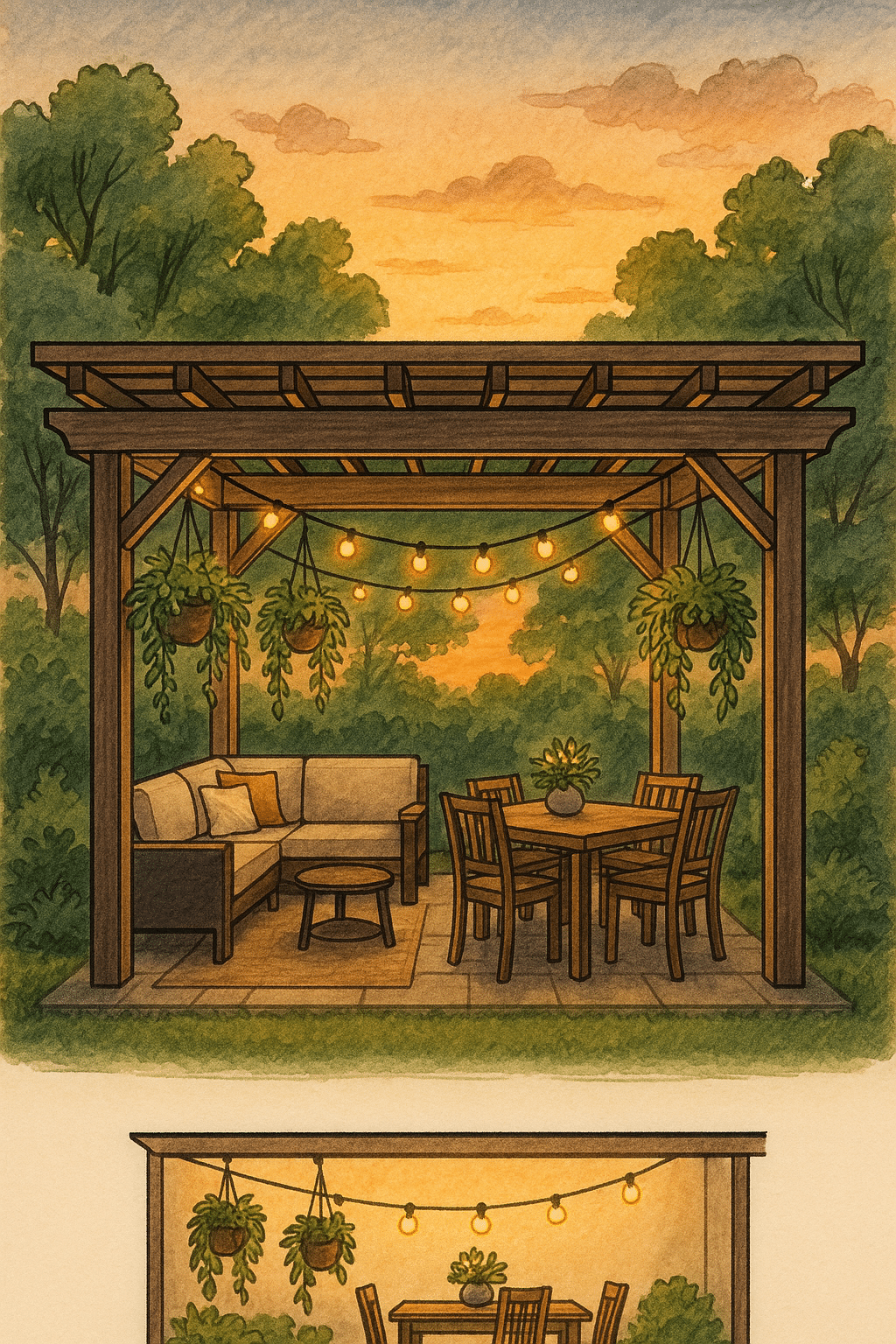
Not every backyard is a sprawling rectangle. Many homeowners face tight quarters, narrow strips, or oddly shaped gardens that challenge traditional design concepts. But don’t let limited space discourage you—there’s plenty of creativity possible here!
Maximizing Vertical Space and Multi-level Landscaping
When horizontal space is tight, the sky and elevations become your best friends. Vertical gardening is a game changer, allowing you to grow plants on walls, trellises, or specialized planters. Think ivy climbing pergolas, herbs in hanging baskets, or succulents in stacked vertical frames.
Multi-level landscaping tricks the eye into perceiving a larger space. Using raised beds, tiers, or platforms—constructed with retaining walls, wood, or stone—separates zones and adds dimension. For instance, a raised dining deck with sitting stairs overlooking a lower garden bed creates functional division without crowding the yard.
Integrating Compact Seating and Dining Areas
Space constraints mean you have to be smart with furniture. Foldable or stackable chairs and tables are excellent for saving room when not in use. Built-in benches or window seats along fences or garden walls provide extra seating without encroaching on the floor space.
Consider a bistro-style dining set for intimate meals or narrow bar counters along one garden edge. Opt for furniture made from weather-resistant materials like aluminum, teak, or synthetic wicker to ensure durability without plastering heavy bulk.
Using Native Plants and Modular Planters
Native plants are well adapted to your local conditions, making them easier to maintain with less water and fertilizer. Plus, their naturally compact growth habit fits well in small or irregularly shaped gardens. Group these in modular planters that can be rearranged depending on the season or your mood.
Modular planters come in various sizes and materials such as cedar wood (for a natural feel), fiberglass (lightweight), or concrete (more permanent). This flexibility allows you to tweak your garden layout over time without a full redesign.
Designing Functional Outdoor Living Spaces with Kitchens and Fire Features
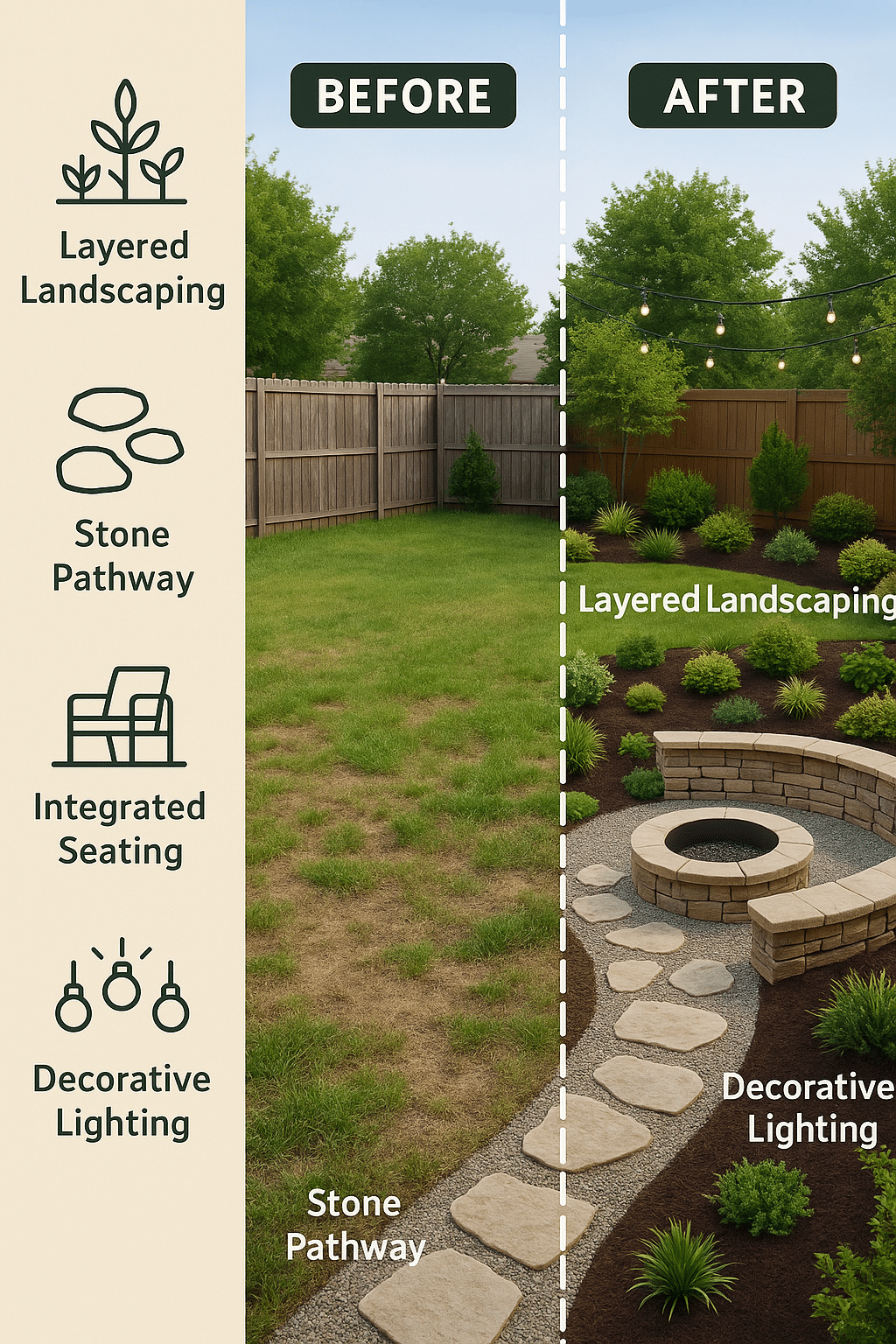
Outdoor living areas go beyond seating and greenery; they invite lifestyle transformation. Integrating kitchens and fire elements engages all the senses and encourages year-round backyard enjoyment.
Outdoor Kitchen Concepts for Seamless Entertaining
An outdoor kitchen transforms backyard cookouts to sophisticated al fresco dining experiences. Key elements include:
- Built-in grill: Gas or charcoal, placed near counter space.
- Prep area: Durable countertops in stone or stainless steel.
- Storage: Weatherproof cabinetry for utensils, dishes, and fuel.
- Cooling: Mini-fridge or cooler for beverages.
- Sink: For easy cleanup.
Depending on your budget and space, outdoor kitchens range from simple grill islands to fully equipped setups with pizza ovens or smokers. Quality materials like granite, concrete, and marine-grade plywood ensure longevity.
One homeowner I worked with expanded their dining season by adding a pizza oven and countertop bar seating, creating a lively gathering spot that blends cooking and socializing beautifully.
Incorporating Fire Pits and Cozy Seating Arrangements
Fire pits add warmth and ambiance, extending time spent outdoors well into chilly evenings. Portable or built-in models made of steel, stone, or concrete fit various budgets and styles.
Circle your fire pit with versatile seating such as Adirondack chairs, cushioned benches with storage, or rustic logs for a natural touch. If you want a modern vibe, sleek sectional sofas with weather-resistant fabrics balance fire warmth with comfort and style.
Safety is paramount—place fire pits away from overhanging branches and use non-flammable ground materials like stone pavers or gravel beneath.
Selecting Durable and Stylish Hardscaping Materials
Hardscaping—non-plant elements like patios, walkways, and retaining walls—forms the foundation of outdoor functionality and aesthetics.
Popular materials include:
- Natural stone: Timeless beauty but higher cost.
- Concrete pavers: Cost-effective with endless pattern options.
- Composite decking: Low maintenance, mimics wood.
- Brick: Classic, with charming texture.
Choose materials that suit your climate and foot traffic. For example, textured pavers resist slipping in wet conditions while permeable materials improve drainage and reduce runoff.
Incorporating Water Features and Sustainable Elements
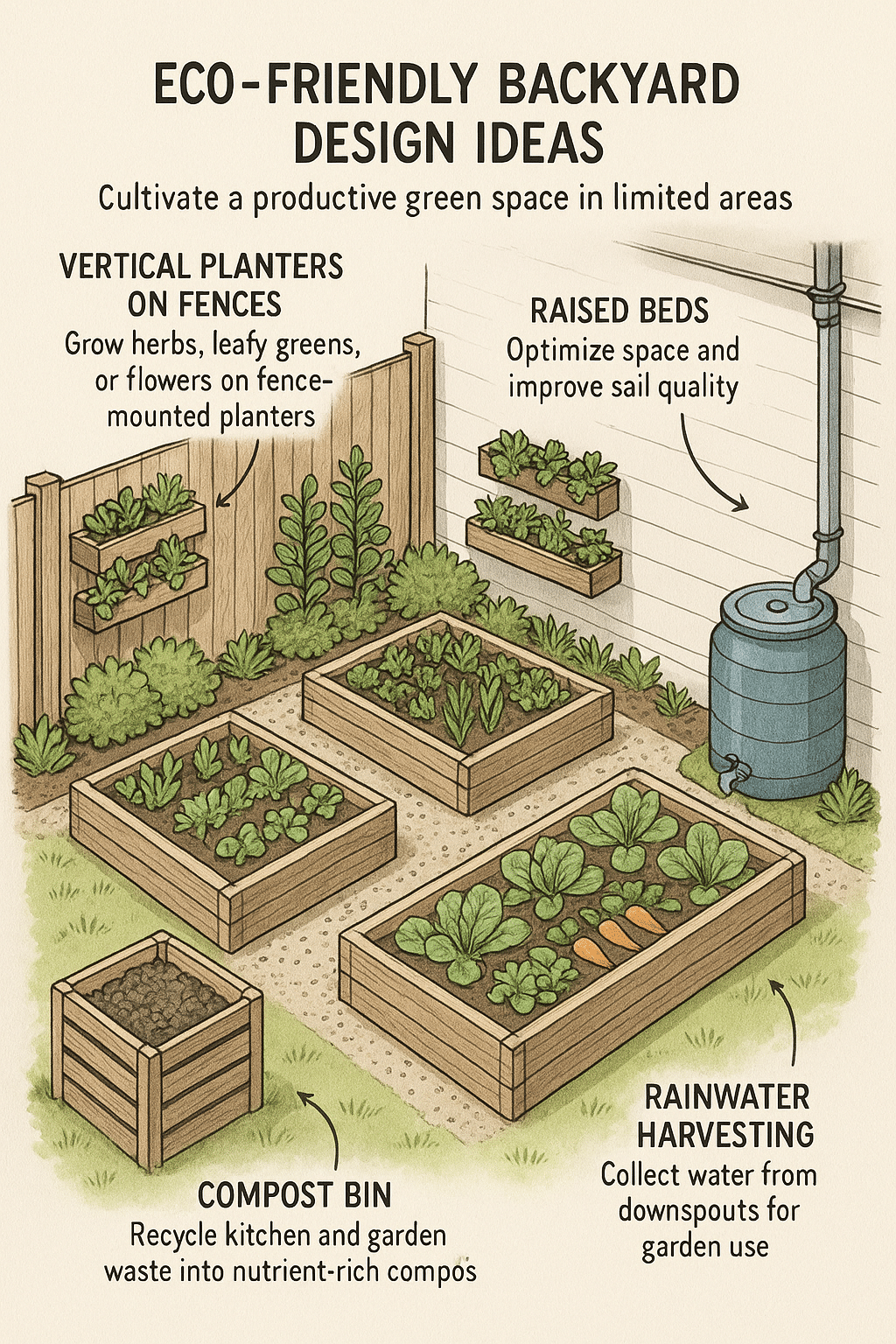
Water features can elevate your backyard into a tranquil retreat while sustainable practices ensure your design respects the environment and reduces upkeep.
Ideas for Ponds, Fountains, and Cascading Waterfalls
Water brings a soothing soundscape and visual dynamism. Consider these options:
- Reflecting pond: Small, still pond with aquatic plants and perhaps koi fish. Requires filtration and maintenance but adds elegance.
- Fountain: Circulating water keeps mosquitoes at bay. Choose styles from classic tiered fountains to modern geometric shapes.
- Cascading waterfall: Multi-tier stone arrangement that helps mask urban noise and adds cooling moisture on hot days.
Placement near seating areas amplifies benefits, but water features must be safe, especially in households with kids or pets.
Using Eco-friendly Materials and Native Plants
Sustainability is the future of backyard design. Use recycled or locally sourced materials for paving and structures to minimize carbon footprint. Incorporate native, drought-tolerant plants to reduce watering needs without sacrificing beauty.
Other eco-friendly choices include rainwater harvesting barrels, solar-powered lighting, and drip irrigation systems that deliver water directly to plant roots efficiently.
Embracing Biophilic Design Principles
Biophilic design connects people with nature, promoting wellbeing and comfort. It involves incorporating natural materials, varied textures, greenery, and organic forms.
For example, blending natural stone pathways with soft moss carpets, positioning seating to capture garden views, and encouraging biodiversity by planting pollinator-friendly flowers all foster a rejuvenating outdoor environment.
Enhancing Backyard Ambiance with Shade and Lighting
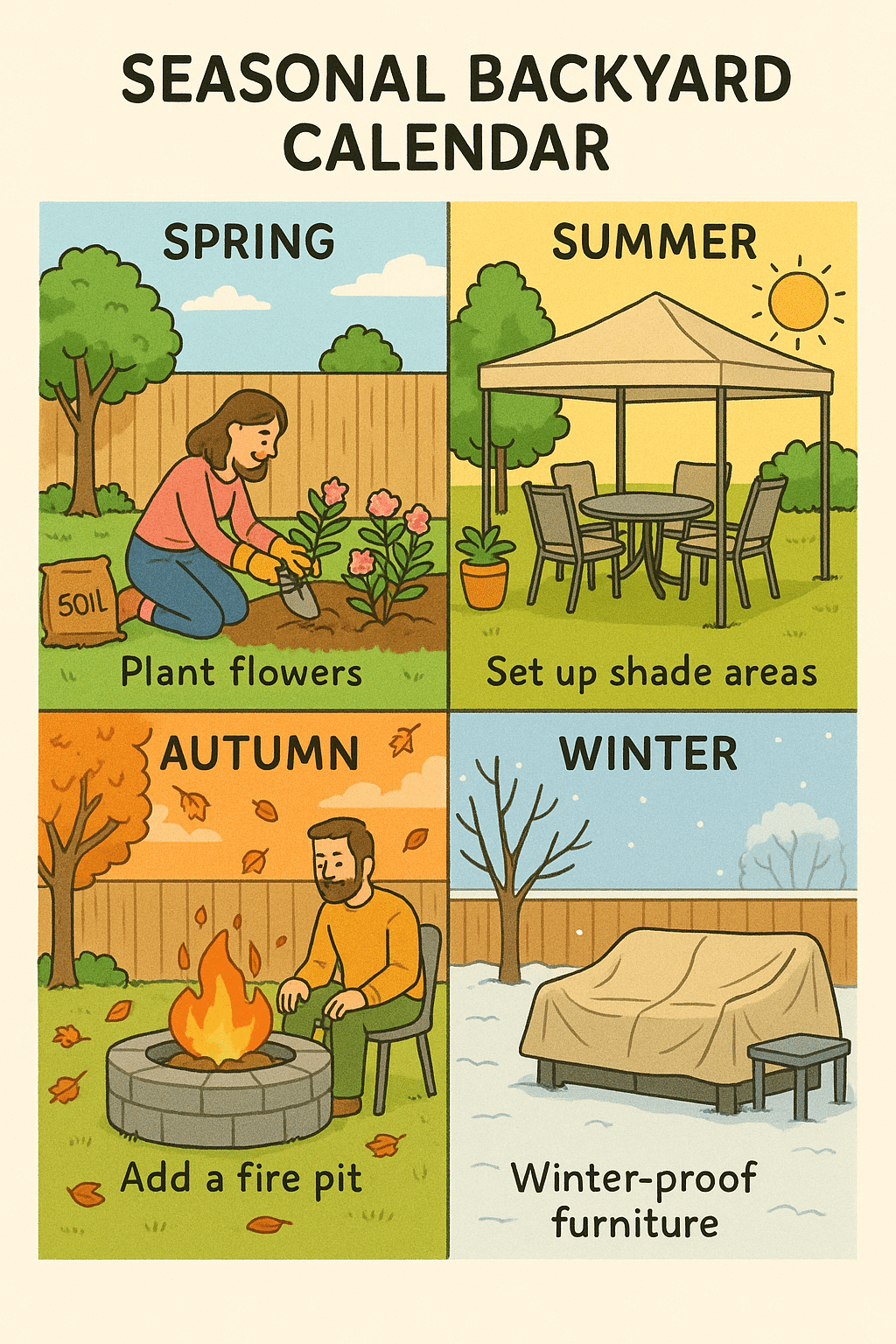
Balanced shade and lighting transform your backyard into a cozy, inviting oasis, perfect from dawn till dusk.
Installing Pergolas, Gazebos, and Other Shade Structures
Shade structures like pergolas and gazebos provide relief from the sun and define outdoor rooms. Here’s how they enhance design:
- Pergolas: Open framework with climbing vines offers dappled shade and an airy feel. Can be fitted with retractable canopies for adjustable shelter.
- Gazebos: Fully or partially enclosed, offering robust protection and focal point for seating or dining zones.
- Awnings and sail shades: Easy-to-install fabric options for instant shading and versatile movement.
Proper material choice (cedar, aluminum, vinyl) depends on weather exposure and desired maintenance levels.
Creative Lighting Techniques for Nighttime Appeal
Lighting sets the mood but also improves safety. Here are practical ideas:
- String lights: Inexpensive, versatile, perfect for pergolas or trees.
- Path lights: Low-level illumination guiding guests through garden paths.
- Spotlights: Highlight architectural features or eye-catching plants.
- LED lanterns: Portable and decorative for tabletops or steps.
Using dimmers and warm-colored bulbs creates a soft, welcoming glow, while timer or motion sensors optimize energy use.
Combining Natural and Modern Lighting Elements
Combining solar-powered stake lights with wired LED strips under benches or along decks blends cutting-edge tech with rustic charm. For instance, soft uplighting on trees contrasts beautifully with modern fixtures embedded in walls or fences. This layered approach increases depth and interest as the sun sets.
Transforming Challenging Landscapes: Steep Slopes and Awkward Shapes
Backyards with tricky topographies or unusual shapes need inspired solutions to unlock their potential and charm.
Terracing and Multi-Level Solutions
For steep slopes, terracing partitions the incline into manageable, flat sections creating planting beds, patios, or seating zones. Retaining walls built from natural stone or timber support soil and prevent erosion.
One family I advised used terraced garden beds for herbs and vegetables, combined with an elevated deck for entertaining, turning a problematic slope into a cohesive and productive space.
Strategic Planting and Seating for Functionality
Select plants with deep roots to stabilize soil and reduce runoff. Shade trees or large shrubs planted midway on slopes help break wind and add privacy.
Seating zones strategically placed on stable terraced levels provide cozy nooks separated from high-traffic areas and blend aesthetics with usability.
Creating Visual Interest Through Texture and Contrast
Mixing textures—rough stone walls with soft grasses or smooth wooden decks with wildflower meadows—injects visual intrigue. Color contrasts, like dark green evergreens against bright flower beds, enliven difficult shapes and draw the eye through the space.
Family-Friendly Backyard Design Ideas
For homeowners with kids or multi-generational families, backyard design must balance style with safety and playfulness.
Play Areas Integrated with Stylish Landscaping
Newton’s law of “play hard, look good” applies here. Use natural materials like mulch or rubberized surfacing in play zones and frame them with neat hedges or flowering shrubs to integrate them into the overall backyard design.
Features such as swings, climbing structures, or sand pits provide fun while matching the garden’s aesthetic. For example, timber playhouses crafted to mimic garden sheds look charming but function well.
Safe and Durable Materials for Children’s Areas
When choosing surfacing or furniture for children, durability and safety are key. Non-toxic finishes, rounded edges, and slip-resistant materials minimize accidents. Soft grass, artificial turf, or poured-in-place rubber are excellent ground covers for falls.
Flexible Spaces for Relaxation and Activity
Design flexibility allows spaces to shift between play, chilling, or hosting BBQs. Movable furniture, foldable tables, and planter boxes on wheels enable adapting the layout as your family grows or seasons change.
Creative Use of Colors, Textures, and Furniture
Personalizing your backyard through design choices lets the space feel genuinely yours.
Blending Modern and Natural Elements for Harmony
Combine sleek, minimalist furniture with rough, natural stone and lush greenery for a balanced look. For instance, a concrete fire pit surrounded by wicker chairs and native plants carries a relaxed yet put-together vibe.
Using Color Palettes Inspired by International Garden Styles
International garden motifs—from the serene greens of Japanese bento gardens to the vibrant hues of Mediterranean courtyards—inspire compelling color schemes. Blue pots, terracotta tiles, or jewel-toned cushions all add character and story.
Selecting Outdoor Furniture for Comfort and Style
Prioritize weather-resistant materials like aluminum, treated teak, or synthetic rattan. Cushion fabrics should be quick drying and UV resistant—brands like Sunbrella are reliable.
Mix seating types (loungers, benches, chairs) to accommodate different needs and foster conversation. Add accessories like throw pillows and outdoor rugs for softness and coziness.
Maintenance Tips to Keep Your Backyard Beautiful Year-round
A stunning backyard needs ongoing care, but smart choices reduce work and boost sustainability.
Low-Maintenance Plant Choices and Materials
Selecting hardy perennials, succulents, and native grasses cuts down pruning and watering. Mulching suppresses weeds and retains soil moisture. For hardscaping, use materials that resist stains, cracking, and fading.
Water Conservation Techniques in Backyard Design
Install drip irrigation systems, rain sensors, and rain barrels to minimize water waste. Group plants with similar water needs for efficiency.
Seasonal Updates and Decor Ideas
Change up cushions, lighting, or potted plant arrangements seasonally for freshness without costly major renovations. Use weatherproof storage for furniture and cushions to extend lifespan.
Budget-Friendly Backyard Design Ideas for Homeowners
A dream backyard doesn’t need a luxury price tag.
DIY Projects to Enhance Outdoor Spaces
Simple DIY projects like pallet wood planters, painted garden stones, or homemade lanterns add personality cheaply. Edging flower beds with reused bricks or stones is another project that can save costs.
Affordable Alternatives for High-End Features
Instead of granite countertops, try stained concrete slabs. Instead of elaborate water fountains, consider solar-powered fountain pumps inside ceramic pots. Artificial turf is cheaper over time compared to maintenance-heavy lawns.
Prioritizing Investment for Maximum Impact
Focus first on functional essentials—patios, seating, and lighting—before moving on to cosmetic touches. Well-planned hardscaping and lighting increase usability and appeal dramatically.
- Understanding your backyard’s size, soil, climate, and functional zones is vital for effective design.
- Vertical and multi-level landscaping unlock potential in small or awkward spaces.
- Outdoor kitchens and fire pits elevate entertaining and outdoor living enjoyment.
- Water features and sustainable landscaping foster tranquility and eco-friendliness.
- Shade structures and layered lighting extend backyard usability into evenings and hot seasons.
- Terracing and texture use transform challenging slopes and shapes into beautiful, functional gardens.
- Family-friendly designs blend safety, style, and versatility for all ages.
- Texture, color, and carefully chosen furniture express personality and improve comfort.
- Low-maintenance plants, water-saving systems, and seasonal décor keep upkeep manageable.
- Budget-friendly, DIY options and smart investment priorities allow for stylish backyards on any budget.
Frequently Asked Questions (FAQs)
1. What are some creative backyard design ideas for small spaces?
Maximizing vertical gardening, installing multi-level raised beds, and using compact, foldable furniture help optimize space. Modular planters with native plants also add greenery without cluttering.
2. How can I affordably update my backyard landscape without spending a fortune?
DIY projects like building planter boxes, creating stone edging from reclaimed materials, and installing solar string lights add charm inexpensively. Prioritize durable hardscaping and flexible seating.
3. What are modern backyard design ideas with outdoor kitchens?
Built-in grills with durable stone countertops, weather-resistant storage cabinets, beverage coolers, and pizza ovens create functional cooking and social zones. Materials like granite and stainless steel ensure longevity.
4. How do I incorporate water features into my backyard design?
Small reflecting ponds, circulating fountains, or cascading waterfalls near seating areas create peaceful ambiance. Use eco-friendly pumps and native aquatic plants to balance beauty and sustainability.
5. What shade structures work best for backyard comfort?
Pergolas with retractable canopies, gazebos, and sail shades offer versatile sun protection. Choose durable materials like cedar or aluminum and enrich with climbing vines for added aesthetics.
Conclusion
Designing your backyard to be both creative and practical is an exciting journey that unlocks the full potential of your outdoor space. From understanding your yard’s unique characteristics to integrating multi-level layouts, outdoor kitchens, and cozy fire features, thoughtful backyard design enhances your home’s livability and value. Embracing sustainable water features and eco-conscious planting makes your garden a peaceful, resilient sanctuary. Meanwhile, strategic shade structures and creative lighting extend the enjoyment from dawn till dusk.
Whether your yard is a tiny nook or steep slope, budget-friendly DIY projects combined with expert tips can transform it into a dynamic outdoor retreat tailored just for your family and lifestyle. Remember, the key lies in balancing beauty with functionality while infusing your personality through textures, colors, and furniture.
Now is the perfect time to start your backyard transformation. Gather your ideas, draw your plans, and embrace the process—your dream outdoor living space awaits! If you want to see more specific product recommendations or need localized plant advice, feel free to explore Houzz or The Spruce to expand your vision with trusted resources.
Happy gardening and designing!

